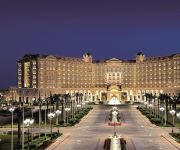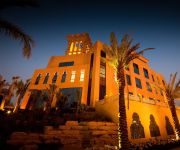Facts and Data
Webpages:
Official Unesco Page
Basis Data:
Unesco World heritage since: 2010
Size of heritage: 29 ha
- Buffer zone: 238 ha
Coordinates:
Longitude: 46,572°
Latitude: 24,734°
Summary
This property was the first capital of the Saudi Dynasty, in the heart of the Arabian Penisula, north-west of Riyadh. Founded in the 15th century, it bears witness to the Najdi architectural style, which is specific to the centre of the Arabian peninsula. In the 18th and early 19th century, its political and religious role increased, and the citadel at at-Turaif became the centre of the temporal power of the House of Saud and the spread of the Wahhabi reform inside the Muslim religion. The property includes the remains of many palaces and an urban ensemble built on the edge of the ad-Dir’iyah oasis.
Location on Map
Show bigger map on Openstreetmap
At-Turaif District in ad-Dir'iyah: A Glimpse into Saudi Arabia's Rich History
The At-Turaif District in ad-Dir'iyah, located at coordinates N24 44 2.88 E46 34 20.88, is a UNESCO World Heritage site that offers a captivating insight into the rich history and cultural heritage of Saudi Arabia. This historic district, situated on the outskirts of Riyadh, the capital city, holds immense significance as it was the birthplace of the first Saudi state and the original home of the Saudi royal family.
Ancient Origins and Historical Significance
The history of the At-Turaif District dates back to the 15th century when it was established as the capital of the Emirate of Diriyah. The district served as the political, economic, and cultural center of the region, playing a pivotal role in the formation of the modern Kingdom of Saudi Arabia.
At-Turaif District witnessed the rise and fall of the first Saudi state, which was founded by Imam Muhammad ibn Saud in 1744. The district's strategic location along the trade routes between Najd and the Arabian Peninsula contributed to its prominence and prosperity. It became a hub for commerce, attracting merchants from various parts of the Arabian Peninsula and beyond.
However, in the early 19th century, the district faced a devastating attack by the Ottoman Empire, leading to its decline and eventual abandonment. The Saudi royal family relocated to Riyadh, leaving At-Turaif District in ruins.
Current State and Restoration Efforts
Today, the At-Turaif District stands as a testament to the glorious past of Saudi Arabia. The site has undergone extensive restoration and preservation efforts to revive its historical significance and showcase its architectural splendor.
The district is characterized by its mud-brick structures, traditional Najdi architecture, and defensive walls. The buildings are adorned with intricate geometric patterns and ornate wooden balconies, reflecting the craftsmanship of the time.
Visitors to the At-Turaif District can explore the restored palaces, mosques, and houses that once housed the ruling elite. The Salwa Palace, built in the 18th century, is a prominent attraction within the district. Its grand halls, courtyards, and gardens provide a glimpse into the opulent lifestyle of the Saudi royal family.
The restoration efforts have also focused on preserving the district's urban layout, which includes narrow streets, public squares, and traditional water management systems. These elements contribute to the authenticity and integrity of the site, allowing visitors to immerse themselves in the atmosphere of the past.
Furthermore, the At-Turaif District serves as a cultural hub, hosting various events and exhibitions that celebrate Saudi Arabia's heritage. The district's museums showcase artifacts, documents, and artworks that shed light on the history, traditions, and customs of the region.
Preserving the Past for the Future
The At-Turaif District in ad-Dir'iyah stands as a symbol of Saudi Arabia's rich cultural heritage and its journey towards modernity. Through meticulous restoration and preservation efforts, this UNESCO World Heritage site offers a unique opportunity for locals and tourists alike to connect with the country's past and appreciate its architectural and historical significance.
As Saudi Arabia continues to embrace its heritage while progressing towards the future, the At-Turaif District serves as a reminder of the importance of preserving and cherishing the cultural treasures that shape a nation's identity.
Hotels and places to stay
The Ritz-Carlton Riyadh
Kempinski Burj Rafal
Al Mashreq Boutique Hotel
Courtyard Riyadh Diplomatic Quarter
DoubleTree by Hilton Hotel Riyadh - Al Muroj Business Gate
Sama Al Qasr Hotel Suites
Nawara Muhamdia Apartments
Crowne Plaza RIYADH RDC HOTEL & CONVENTION
Hotel Al Khozama-Worldhotels
Swiss Spirit Metropolitan
Videos from the area
Videos provided by Youtube are under the copyright of their owners.












